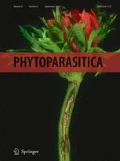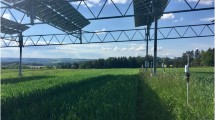Abstract
Soil solarization (SoSol) with a single layer of transparent polyethylene (PE) film, traps considerable heat and moisture in soil. Solarization of field soil with two layers of 1 mil (25 μm thick) PE film, separated by a 6-cm air layer, caused soil temperatures at 15 cm depth to rise by 12.7°C and 3.6°C over those in noncovered soil or soil covered by one layer of film, respectively; at 30 cm depth the respective differences in temperature were 11.2°C and 2.7°C. Viability of propagules (mainly chlamydospores) ofFusarium oxysporum f. sp.vasinfectum that had been buried at 30 cm depth, was reduced after 31 days of solarization by 97.5%, 58%, and 0% under a double film layer, a single layer, and in non-covered soil, respectively. The insulating effect of a double layer of PE film improved heat retention in soil and the solarization effect.
Similar content being viewed by others
References
Garibaldi, A. and Tamietti, G. (1983) Attempts to use soil solarization in closed glasshouses in northern Italy for controlling corky root of tomato.Acta Hort. 152:237–243.
Katan, J. (1981) Solar heating (solarization) of soil for control of soilborne pests.A. Rev. Phytopath. 19:211–236.
Overman, A.J. and Jones, J.P. (1986) Efficacy of soil solarization in full-bed mulch culture of tomato.J. Nematol. 18:625 (abstr.).
Pullman, G.S., DeVay, J.E., Garber, R.H. and Weinhold, A.R. (1979) Control of soil-borne pathogens by plastic tarping of soil.in: Schippers, B. and Gams, W. [Eds.] Soil-Borne Plant Pathogens. Academic Press, New York, NY. pp. 439–446.
Raymundo, S.A. and Alcazar, J. (1986) Increasing efficiency of soil solarization in controlling root-knot nematodes by using two layers of plastic mulch.J. Nematol. 18:628 (abstr.).
Smith, S.N. and Snyder, W.C. (1975) Persistence ofFusarium oxysporum f. sp.vasinfectum in fields in the absence of cotton.Phytopathology 65:190–196.
Stapleton, J.J. and DeVay, J.E. (1986) Soil solarization: a nonchemical approach for management of plant pathogens and pests.Crop Prot. 5:190–198.
Author information
Authors and Affiliations
Rights and permissions
About this article
Cite this article
Ben-Yephet, Y., Stapleton, J.J., Wakeman, R.J. et al. Comparative effects of soil solarization with single and double layers of polyethylene film on survival ofFusarium oxysporum F. SP.Vasinfectum . Phytoparasitica 15, 181–185 (1987). https://doi.org/10.1007/BF02979581
Received:
Revised:
Issue Date:
DOI: https://doi.org/10.1007/BF02979581




